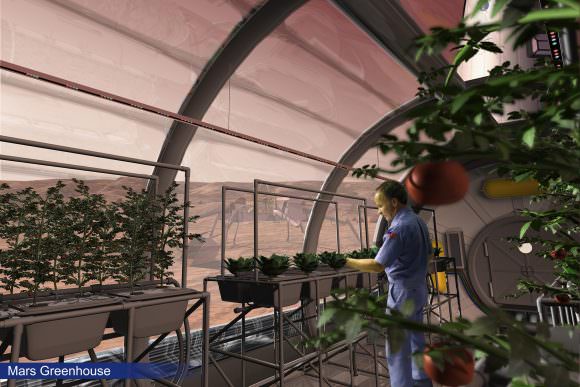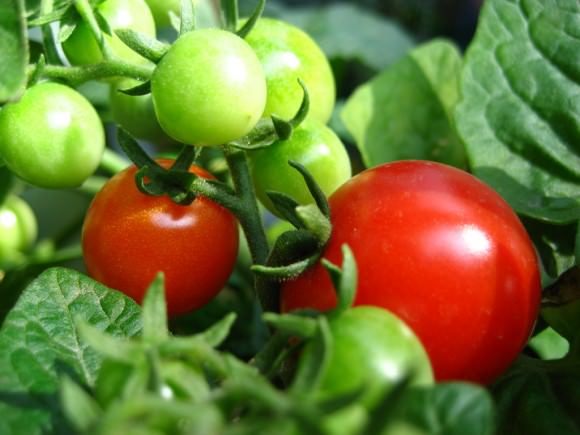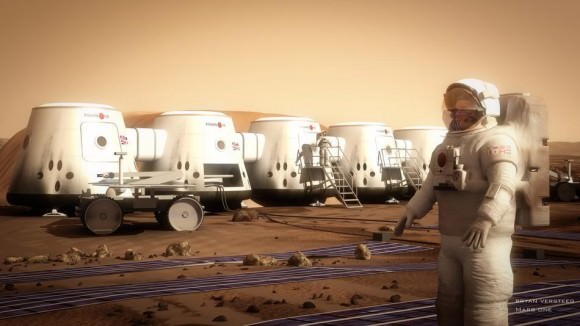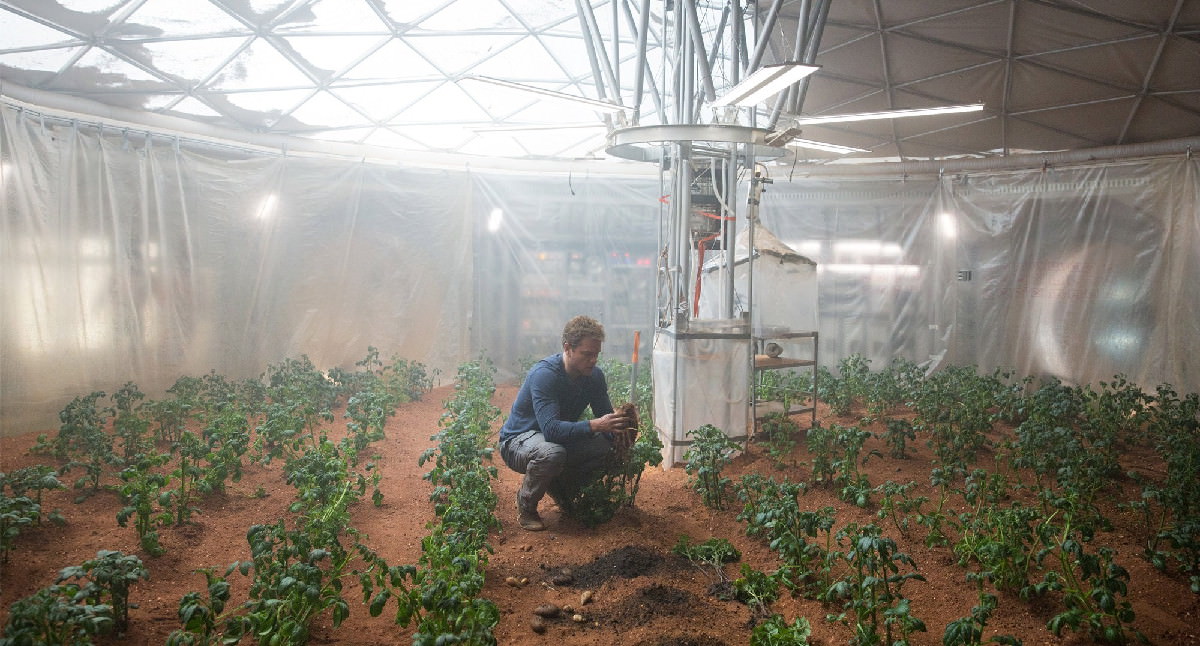When your stated purpose is to send settlers to Mars by 2026, you’re sure to encounter a lot of skepticism. And that is exactly what Dutch entrepreneur Bas Lansdorp has been dealing with ever since he first went public with MarsOne in 2012. In fact, in the past four years, everything from the project’s schedule, technical and financial feasibility, and ethics have been criticized by scientists, engineers and people in the aerospace industry.
However, Lansdorp and his organization have persevered, stating that they intend to overcome all the challenges in sending people on a one-way trip to the Red Planet. And in their most recent statement, MarsOne has announced that they have addressed the all-important issue of what their settlers will eat. In an experiment that feels like it was ripped from the The Martian, MarsOne has completed testing different types of crops in simulated Martian soil, to see which ones could grow on Mars.
Located in the Dutch town of Nergena, MarsOne maintains a glasshouse complex where they have been conducting experiments. These experiments took place in 2013 and 2015, and involved Martian and Lunar soil simulants provided by NASA, along with Earth soil as a control group.

Using these, a team of ecologists and crop scientists from the Wageningen University & Research Center have been testing different kinds of seeds to see which ones will grow in a Lunar and Martian environment. These have included rye, radishes, garden cress and pea seed. And earlier this year, they added a crop of tomatoes and potatoes to the mix.
As Dr. Wieger Wamelink, the ecologist who led the experiments, told Universe Today via email:
“We started our first experiment in 2013 (published in Plos One in 2014) to investigate if it was possible to grow plants in Mars and moon soil simulants. We assume that plants will be grown indoors, because of the very harsh circumstances on both Mars and moon, very cold, no or almost no atmosphere and way to much cosmic radiation. That first experiment only had a few crops and mostly wild plants and clovers (for nitrogen binding from the atmosphere to manure the soil).”
After confirming that the seeds would germinate in the simulated soil after the first year, they then tested to see if the seeds from that harvest would germinate in the same soil to create another harvest. What they found was quite encouraging. In all four cases, the seeds managed to germinate nicely in both Martian and Lunar soil.

“Our expectation were very low,” said Wamelink, “so we were very surprised that on the Mars soil simulant plants grew rather well and even better than on our nutrient poor control earth soil. There were also problems, the biggest that it was very difficult to keep the soil moist and that though on Mars soil simulant there was growth it was not very good, i.e. the amount of biomass formed was low.”
And while they didn’t grow as well as the control group, which was grown in Earth soil, they did managed to produce time and again. This was intrinsic to the entire process, in order to make sure that any crops grown on Mars would have a full life-cycle. Being able to grow crops, replant seeds, and grow more would eliminate the need to bring new seeds for every crop cycle, thus ensuring that Martian colonists could be self-sufficient when it came to food.
In 2015, they conducted their second experiment. This time around, after planting the seeds in the simulated soil, they added organic matter to simulate the addition of organic waste from a previous crop cycle. And on every Friday, when the experiments were running, they added nutrient solution to mimic the nutrients derived from fecal matter and urine (definite echoes of The Martian there!).
Once again, the results were encouraging. Once again, the crops grew, and the addition or organic matter improved the soil’s water-holding capacity. Wamelink and his team were able to harvest from many of the ten crops they had used in the experiment, procuring another batch of radishes, tomatoes and peas. The only crop that did poorly was the batch of spinach they had added.
This year, the team’s experiments were focused on the issue of food safety. As any ecologist knows, plants naturally absorb minerals from their surrounding environment. And tests have shown that soils obtained from the Moon and Mars show concentrations of heavy metals and toxins – such as arsenic, cadmium, copper, lead, and iron (which is what gives Mars its reddish appearance). As Wamelink described the process:
“Again we have ten crops, but slightly different crops from last year; we included green beans and potatoes (best food still and Mark Watney also seems to love potatoes). Also repeated was the addition of organic matter, to mimic the addition of the plant parts that are not eaten from a previous growth cycle. Also new is the addition of liquid manure, to mimic the addition of human faeces… We know that both Mars and moon soil simulants contain heavy metals, like led, copper, mercury and chrome. The plants do not care about this, however when they end up in the eaten parts then they could poison the humans that eat them. There we have to test if it is safe to eat them.”
And again, the results were encouraging. In all cases, the crops showed that the concentrations of metals they contained were within human tolerances and therefore safe to eat. In some cases, the metal concentrations were even lower than that found those grown using potting soil.
“We now tested four species we harvested last year as a preliminary investigation and it shows that luckily there are no harmful quantities present in the fruits, so it is safe to eat them,” said Wamelink. “We will continue these analyses, because for the FDA they have to be analysed in fresh fruits and vegetables, where we did the analyses on dried material. Moreover we will also look at the content of large molecules, like vitamins, flavonoids (for the taste) and alkaloids (for toxic components).”
However, the Wageningen UR team hopes to test all ten of the crops they have grown in order to make sure that everything grown in Martian soil will be safe to eat. Towards this end, Wageningen UR has set up a crowdfunding campaign to finance their ongoing experiments. With public backing, they hope to show that future generations will be able to be self-sufficient on Mars, and not have to worry about things like arsenic and lead poisoning.
As an incentive, donors will receive a variety of potential gifts, which include samples of the soil simulant used for the experiment. But the top prize, a a dinner based on the harvest, is being offered to people contributing €500 ($555.90 USD) or more. In what is being called the first “Martian meal” this dinner will take place once the experiment is complete and will of course include Martian potatoes!
Looking ahead, Wamelink and his associates also hope to experiment crops that do not rely on a seed-to-harvest cycle, and are not harvested annually.These include fruit trees so that they might be able to grow apples, cherries, and strawberries in Martian soil. In addition, Wamelink has expressed interest in cultivating lupin seeds as a means of replacing meat in the Martian diet.
And when it comes right down to it, neither MarsOne or the Wageningen UR team are alone in wanting to see what can be grown on Mars or other planets. For years, NASA has also been engaged in their own tests to see which crops can be cultivated on Mars. And with the help of the Lima-based International Potato Center, their latest experiment involves cultivating potatoes in samples of Peruvian soil.

For hundreds of years, the Andean people have been cultivating potatoes in the region. And given the arid conditions, NASA believes it will serve as a good facsimile for Mars. But perhaps the greatest draw is the fact cultivating potatoes in a simulated Martian environment immediately calls to mind Matt Damon in The Martian. In short, it’s a spectacular PR move that NASA, looking to drum up support for its “Journey to Mars“, cannot resist!
Naturally, experiments such as these are not just for the sake of meeting the challenges posed by MarsOne’s plan for one-way crewed missions to Mars. Alongside the efforts of NASA and others, they are part of a much larger effort to address the challenges posed by the renewed era of space exploration we find ourselves embarking on.
With multiple space agencies and private corporations (like SpaceX) hoping to put buts back on the Moon and Mars, and to establish permanent bases on these planets and even in the outer Solar System, knowing what it will take for future generations of colonists and explorers to sustain themselves is just good planning.
Further Reading: Mars Exchange

